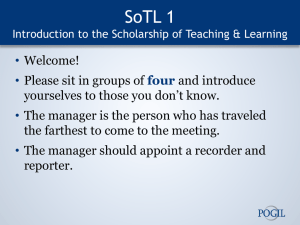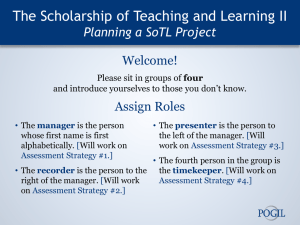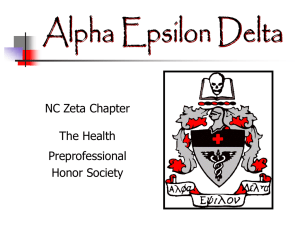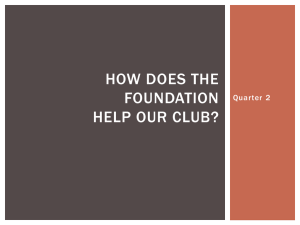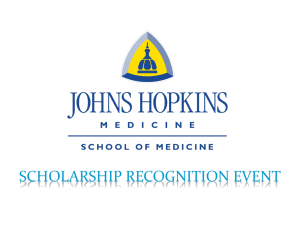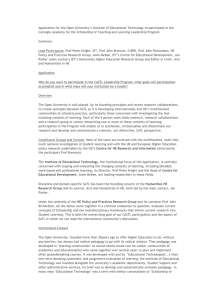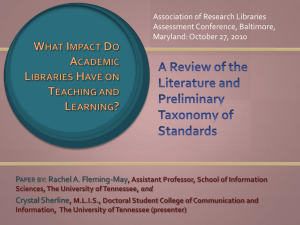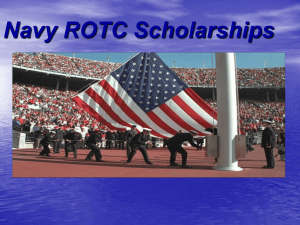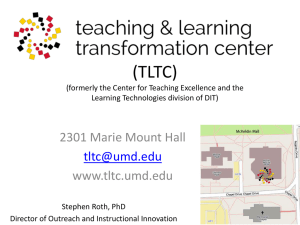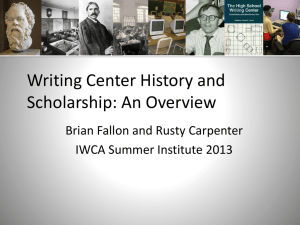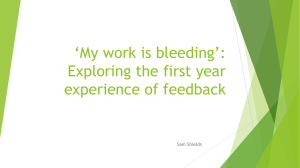The Scholarship of Teaching and Learning in Engineering
advertisement
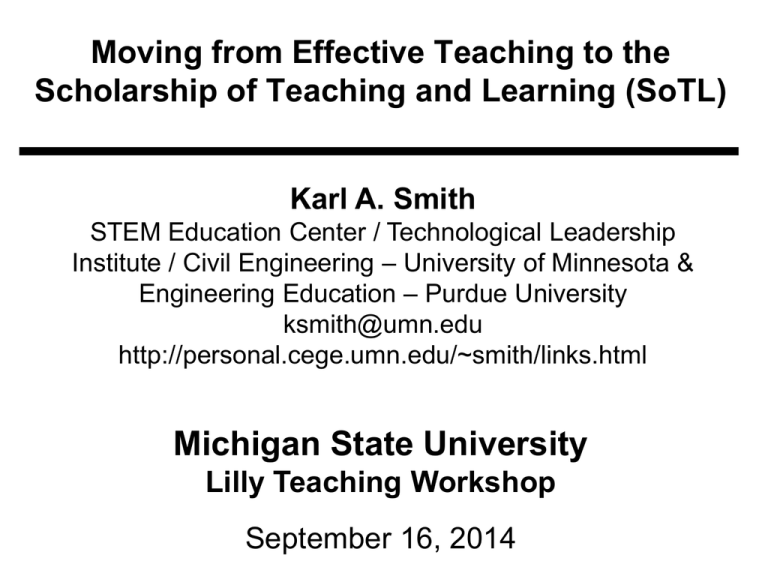
Moving from Effective Teaching to the Scholarship of Teaching and Learning (SoTL) Karl A. Smith STEM Education Center / Technological Leadership Institute / Civil Engineering – University of Minnesota & Engineering Education – Purdue University ksmith@umn.edu http://personal.cege.umn.edu/~smith/links.html Michigan State University Lilly Teaching Workshop September 16, 2014 Workshop Layout • Welcome & Overview • Background – Designing effective learning environments – Boyer – Scholarship Reconsidered – Hutchings & Shulman – Levels of Inquiry • Scholarship of Teaching and Learning (SoTL) – – – – – Definition Participant Survey Rationale Resources Practice • Advancing Along the Levels of Inquiry – Suggestions and Strategies • Summary and Next Steps Workshop Objectives • Participants will be able to – Describe innovation cycle of educational practice and research and its role in designing effective learning environments – Describe key features of SoTL and how it differs from Scholarly Teaching and Discipline-Based Education Research – Explain rationale for SoTL – Identify SoTL opportunities in courses and programs – Locate SoTL resources 4 SoTL Example Video from the University of Minnesota Good Teacher Project YouTube: http://youtu.be/2BkUnwrGPQI SoTL Interests • Describe your interest in SoTL and your goals for engaging in SoTL work. • Individually identify a few interests and goals – Please record them • Report to the group • Short Exercise - 4-5 min – Think individually ~1 min – Discuss in your group ~ 2 min – Select a few ideas to share with virtual group ~1 min 6 Scholarship Reconsidered: Priorities of the Professoriate Ernest L. Boyer • The Scholarship of Discovery, research that increases the storehouse of new knowledge within the disciplines; • The Scholarship of Integration, including efforts by faculty to explore the connectedness of knowledge within and across disciplines, and thereby bring new insights to original research; • The Scholarship of Application, which leads faculty to explore how knowledge can be applied to consequential problems in service to the community and society; and • The Scholarship of Teaching, which views teaching not as a routine task, but as perhaps the highest form of scholarly enterprise, involving the constant interplay of teaching and learning. Boyer, Ernest L. 1990. Scholarship reconsidered: Priorities for the professoriate. Princeton, NJ: The Carnegie Foundation for the Advancement of Teaching. Levels of Education Inquiry • Level 0 Teacher – Teach as taught • Level 1 Effective Teacher – Teach using accepted teaching theories and practices • Level 2 Scholarly Teacher – Assesses performance and makes improvements • Level 3 Scholarship of Teaching and Learning – Engages in educational experimentation, shares results • Level 4 Discipline Based Education Researcher – Conducts educational research, publishes archival papers Source: Streveler, R., Borrego, M. and Smith, K.A. 2007. Moving from the “Scholarship of Teaching and Learning” to “Educational Research:” An Example from Engineering. Improve the Academy, Vol. 25, 139-149. Levels of Inquiry • Level 1: Excellent teaching – Involves the use of good content and teaching and assessing methods • Level 2: Scholarly Teaching – Involves good content and methods and classroom assessment and evidence gathering, informed by best practice and best knowledge, inviting of collaboration and review. Levels of Inquiry (cont’d) • Level 3: Scholarship of Teaching and Learning – The Instructor (a) Is aware of modern pedagogical developments and incorporates them in his/her teaching where appropriate, and (b) Reflects on, assesses, and attempts to improve his/her teaching (classroom research) – Is public and open to critique and evaluation, is in a form that others can build on, involves question-asking, inquiry and investigation, particularly about student learning. The research process and reasoning Practical Problem and helps motivates Research Answer Research Question leads to informs Research Problem Research Process Warrant Claim Reason Evidence Acknowledgment and Response Research Reasoning “It could well be that faculty members of the twenty-first century college or university will find it necessary to set aside their roles as teachers and instead become designers of learning experiences, processes, and environments.” James Duderstadt, 1999 Nuclear Engineering Professor; Former Dean, Provost and President of the University of Michigan Course Design Foundations Science of Instruction (UbD) No Yes Yes Science of Learning (HPL) No Good Theory/ Poor Practice Good Theory & Good Practice Good Practice/ Poor Theory Bransford, Brown & Cocking. 1999. How People Learn. National Academy Press. Wiggins & McTighe, 2005. Understanding by Design, 2ed. ASCD. SoTL Experience • Individually: Reflect on SoTL Activities – – – – – Subscribe to teaching journals? Read/skim teaching journals? Attended teaching conferences/workshops? Published articles on teaching & learning? Other activity in scholarship of teaching and learning? • Attended a teaching effectiveness workshop • Introduced new teaching strategy and/or content and assessed for improvement of learning • Discuss in Groups of 3-4 – Share SoTL experiences/activities • Prepare 2-3 stories to share with the larger group Why should we care about SoTL? January 2, 2009—Science, Vol. 323 – www.sciencemag.org One Reason - Calls for evidence-based instructional practices Engaged Pedagogies = Reduced Failure Rates Evidence-based research on learning indicates that when students are actively involved in their education they are more successful and less likely to fail. A new PNAS report by Freeman et al., shows a significant decrease of failure rate in active learning classroom compared to traditional lecture Freeman, Scott; Eddy, Sarah L.; McDonough, Miles; Smith, Michelle K.; Okoroafor, Nnadozie; 16 Jordt, Hannah; Wenderoth, Mary Pat; Active learning increases student performance in science, engineering, and mathematics, 2014, Proc. Natl. Acad. Sci. Discipline-Based Education Research (DBER) Report Update Discipline-Based Education Research Practitioner Guide In Preparation Coming 2014 “Reaching Students: What Research Says About Effective Instruction in Undergraduate Science and Engineering” ASEE Prism Summer 2013 National Research Council Summer 2012 – http://www.nap.edu/ catalog.php?record_id=13362 Journal of Engineering Education Editorial – October, 2013 Why do SoTL? • ? 18 Why do SoTL? • Fosters significant, long-lasting learning for all students • Enhances practice and profession of teaching • Brings faculty’s work as teachers into the scholarly realm. • ? http://www.carnegiefoundation.org/publications/the-scholarship-teaching-andlearning-reconsidered-institutional-integration-and-impact http://www.carnegiefoundation.org/scholarship-teaching-learning http://academics.georgiasouthern.edu/ce/conferences/sotlcommons/ http://digitalcommons.georgiasouthern.edu/ij-sotl/ http://serc.carleton.edu/index.html Faculty involved in SoTL “frame and systematically investigate questions related to student learning—the conditions under which it occurs, what it looks like, how to deepen it, etc.… and do so with an eye not only to improving their own classrooms but also to advancing practice beyond it.” What differentiates SoTL from the ongoing selfassessment of our own teaching is that it is “public, peer-reviewed and critiqued, and exchanged with other members of our professional communities.” Pat Hutchings and Lee Shulman of the Carnegie Foundation SoTL Practice • Settings (~4 – 8 minute videos) – Physics – Harvard – Teaching through questioning – Biology – UMN – SCALE-UP – Physics – MIT – Studio physics • Instructor emphasis (student learning outcomes): – Conceptual understanding – Systematic problem formulation and solving • Watch video with viewing partner (faculty focus & student focus) – Identify potential questions for SoTL study Basic Features of Professional and Scholarly Work • It requires a high level of discipline-related expertise • It is conducted in a scholarly manner with clear goals, adequate preparation, and appropriate methodology • The work and its results are appropriately and effectively documented and disseminated. This reporting should include a reflective critique that addresses the significance of the work, the process that was used, and what was learned. • It has significance beyond the individual context. • It breaks new ground or is innovative. • It can be replicated or elaborated on. • The work both process and product or result is reviewed and judged to be meritorious and significant by a panel of ones peers. Diamond, R., “The Mission-Driven Faculty Reward System,” in R.M. Diamond, Ed., Field Guide to Academic Leadership, San Francisco: Jossey-Bass, 2002 Video Examples • Mazur – From Questions to Concepts – Physics – Harvard https://www.youtube.com/watch?v=wont2v_LZ1 E • Wright – Inside Active Learning Classrooms – Biology – University of Minnesota http://www.youtube.com/watch?v=lfT_hoiuY8w • Belcher – Technology Enabled Active Learning – Physics – MIT http://web.mit.edu/edtech/casestudies/teal.html# video Types of Questions • Instructional Knowledge—components of instructional design • Pedagogical Knowledge—student learning & how to facilitate it • Curricular Knowledge—goals, purposes & rationales for courses or programs 3 types of reflection within each form of knowledge • Content—What should I do… • Process—How did I do… • Premise—Why does it matter… Examples for process reflection: How did I (we) do at: • Course design, methods & assessing effectively? (instructional) • Facilitating student knowledge? Was I successful? (pedagogical) • Arriving at goals & rationale for courses? (curricular) SoTL Futures • Reflection Questions: – Are you interested in developing a SoTL project? Why-why not? – If yes, what question(s) would you explore? – What organizational resources and or support is available? – What organizational challenges do you face? – Thoughts on helping prepare the next generation of faculty for SoTL work? • Discuss in Groups of 3-4 – Share responses • Prepare 2-3 responses to share with the larger group Workshop Resources • Articles – Fairweather, J. 2008. Linking Evidence and Promising Practices in Science, Technology, Engineering, and Mathematics (STEM) Undergraduate Education http://www7.nationalacademies.org/bose/Fairweather_CommissionedPaper.pdf – Streveler, R., Borrego, M. and Smith, K.A. 2007. Moving from the “Scholarship of Teaching and Learning” to “Educational Research:” An Example from Engineering. Silver Anniversary Edition of To Improve the Academy, Vol. 25, 139-149. – Wankat, P.C., Felder, R.M., Smith, K.A. and Oreovicz, F. 2001. The scholarship of teaching and learning in engineering. In Huber, M.T & Morreale, S. (Eds.), Disciplinary styles in the scholarship of teaching and learning: A conversation. San Francisco: Jossey-Bass. • Websites – International Journal of the Scholarship of Teaching and Learning http://academics.georgiasouthern.edu/ijsotl/index.htm – Carnegie Academy for the Scholarship of Teaching and Learning (CASTL) http://www.carnegiefoundation.org/scholarship-teaching-learning – Collaboratory for Engineering Education Research - cleerhub.org • Books – Booth, W.C., G.G. Colomb, and J.M. Williams. 2008. The craft of research. 3rd ed. Chicago, Il: The University of Chicago Press – National Research Council. 2002. Scientific research in education. R.J. Shavelson and L. Towne, eds. Washington, DC: The National Academies Press; http://www.nap.edu/openbook.php?record_id=10236&page=R1 – National Research Council. 2012. Discipline Based Education Research. S.R. Singer, N.R. Nielsen, and H.A. Schweingruber, eds. http://www.nap.edu/catalog.php?record_id=13362 Guiding principles for scientific research in education 1. Pose significant questions that can be investigated empirically 2. Link research to relevant theory 3. Use methods that permit direct investigation of the question 4. Provide coherent, explicit chain of reasoning 5. Replicate and generalize across studies 6. Disclose research to encourage professional scrutiny and critique Source: Scientific Research in Education, National Research Council, 2002 Additional Resources • Recommended – Benson, L., Becker, K., Cooper, M. Griffin, H. & Smith, K. 2010. Engineering Education: Departments, Degrees and Directions. International Journal of Engineering Education, 26 (5), 1042-1048. – Borrego, M., R.A. Streveler, R.L. Miller, and K.A. Smith. 2008. A new paradigm for a new field: Communicating representations of engineering education research. Journal of Engineering Education 97 (2): 147-162. – Duderstadt, J. J. 2008. Engineering for a changing world: A roadmap to the future of engineering practice, research, and education. The Millennium Project, The University of Michigan. (http://milproj.dc.umich.edu/) – Jamieson, L.H. and Lohmann, J. R. 2009. Creating a culture for scholarly and systematic innovation in engineering education. Washington, DC: American Society for Engineering Education. – Paulsen, M. B. 2001. The relation between research and the scholarship of teaching. New Directions for Teaching and Learning: No. 86, pp. 19-29. – Streveler, R.A., and K.A. Smith. 2006. Conducting rigorous research in engineering education. Journal of Engineering Education 95 (2): 103-105. – Streveler, R.A. and Smith, K.A. 2010. From the Margins to the Mainstream: The Emerging Landscape of Engineering Education Research. Journal of Engineering Education, 99(4), 285-287. Additional Resources • Additional – – – – – – – – – – – Adams, R., L. Fleming, and K. Smith. 2007. Becoming an engineering education researcher: Three researchers stories and their intersections, extensions, and lessons. Proceedings, International Conference on Research in Engineering Education; http://www.ce.umn.edu/~smith/docs/AdamsFleming-Smith-Becoming_an_engineering_education_researcher-ICREE2007.pdf Booth, W.C., G.G. Colomb, and J.M. Williams. 2008. The craft of research. 3rd ed. Chicago, Il: The University of Chicago Press. Boyer, Ernest L. 1990. Scholarship reconsidered: Priorities for the professoriate. Princeton, NJ: The Carnegie Foundation for the Advancement of Teaching. Center for the Advancement of Scholarship on Engineering Education; http://www.nae.edu/nae/caseecomnew.nsf Diamond, R., “The Mission-Driven Faculty Reward System,” in R.M. Diamond, Ed., Field Guide to Academic Leadership, San Francisco: Jossey-Bass, 2002 Diamond R. & Adam, B. 1993. Recognizing faculty work: Reward systems for the year 2000. San Francisco, CA: Jossey-Bass. Journal of Engineering Education; http://www.asee.org/publications/jee/index.cfm Hutchings, P., and Shulman, L.S. 1999. The scholarship of teaching: New elaborations, new developments. Change, 31 (5), 10-15. http://www.carnegiefoundation.org/publications/sub.asp?key=452&subkey=613 National Research Council. 2002. Scientific research in education. R.J. Shavelson and L. Towne, eds. Washington, DC: The National Academies Press; http://www.nap.edu/openbook.php?record_id=10236&page=R1 Shulman, Lee S. 1999. Taking learning seriously. Change, 31 (4), 11-17. Smith, K.A. 2006. Continuing to build engineering education research capabilities. IEEE Transactions on Education 49 (1): 1-3; http://www.asee.org/conferences/international/2008/upload/Continuing-to-Build-Eng-EducationResearch-Capabilities.pdf Contact Information: • Karl A. Smith, Ph.D. Morse-Alumni Distinguished Teaching Professor Emeritus Professor of Civil Engineering STEM Education Center Technological Leadership Institute University of Minnesota (Part Time) http://personal.cege.umn.edu/~smith/links.html Cooperative Learning Professor of Engineering Education School of Engineering Education Purdue University (Part Time) https://engineering.purdue.edu/ENE/ E-mail: ksmith@umn.edu Skype: kasmithtc Thanks for your participation! • To download a copy of the presentation - go to: http://personal.cege.umn.edu/~smith/links.html • Please complete the assessment
